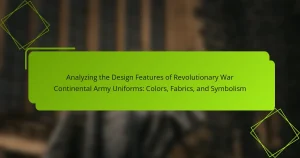The U.S. Army combat uniform has undergone significant evolution to meet the demands of modern warfare, featuring the Operational Camouflage Pattern (OCP) for effective concealment across various environments. Key design elements include durable, lightweight materials that enhance mobility, reinforced areas for durability, moisture-wicking properties for comfort, and multiple pockets for functionality. Historical developments highlight a transition from visibility-focused designs to advanced camouflage and technological integrations, such as smart fabrics that monitor soldier performance. Future trends indicate a focus on sustainability, customization, and enhanced communication systems, aiming to improve soldier effectiveness and safety in the field.

What are the key features of U.S. Army combat uniforms?
U.S. Army combat uniforms feature a camouflage pattern for concealment. They utilize the Operational Camouflage Pattern (OCP) for effective blending in various environments. The fabric is made from durable, lightweight materials to enhance mobility and comfort. The uniforms include reinforced areas for increased durability in high-wear zones. They are designed with multiple pockets for functionality and storage of essential gear. The uniforms are moisture-wicking to manage sweat and enhance comfort during physical activities. They incorporate a loop field for attaching insignia and name tapes. The design also allows for easy layering with body armor and other protective gear.
How have the design features evolved over time?
The design features of U.S. Army combat uniforms have evolved significantly over time. Initially, uniforms were primarily wool and cotton, which provided limited functionality. In the 1960s, the introduction of the Battle Dress Uniform (BDU) marked a shift to a more practical design with camouflage patterns. The BDU utilized ripstop fabric, enhancing durability and reducing weight.
In the 2000s, the Army adopted the Army Combat Uniform (ACU), which included features like a mandarin collar and improved pocket placement for better accessibility. The ACU also introduced moisture-wicking materials, enhancing comfort in various climates.
Recent advancements include the Operational Camouflage Pattern (OCP), which was implemented to improve concealment in diverse environments. The OCP features a blend of colors that adapt to different terrains. Additionally, the integration of advanced materials, such as flame-resistant fabrics, has improved soldier safety.
Overall, the evolution reflects a continuous effort to enhance functionality, comfort, and safety in combat uniforms.
What historical events influenced the design changes?
The design changes of U.S. Army combat uniforms were influenced by several historical events. World War II necessitated functional designs for improved soldier performance. The Vietnam War introduced the need for camouflage patterns suited to jungle environments. The Gulf War highlighted the importance of durable materials and desert camouflage. The September 11 attacks prompted a shift towards uniforms that could accommodate advanced technology. Each event required adaptations to enhance operational effectiveness and soldier safety. These historical contexts shaped the evolution of uniform design significantly.
What are the most significant design elements in modern uniforms?
The most significant design elements in modern uniforms include functionality, comfort, and camouflage. Functionality ensures that uniforms support the operational needs of personnel. This includes pockets, reinforced seams, and adjustable features. Comfort is achieved through the use of breathable and moisture-wicking materials. These materials enhance wearability during extended use. Camouflage patterns are designed to blend seamlessly with various environments. This helps personnel remain undetected in the field. Additionally, modern uniforms often incorporate advanced textiles for durability and protection. These innovations reflect the evolving demands of military operations.
What materials are commonly used in U.S. Army combat uniforms?
U.S. Army combat uniforms are commonly made from a blend of cotton and polyester. This combination provides durability and comfort for soldiers. The cotton offers breathability, while polyester enhances moisture-wicking properties. Additionally, ripstop fabric is often used for its resistance to tearing and ripping. The use of flame-resistant materials is also a standard for combat uniforms. These materials are designed to protect soldiers from heat and flames. The specific fabric used can vary based on the uniform type and operational requirements. Overall, these materials ensure that uniforms meet the demands of various combat environments.
How do these materials impact functionality and durability?
Materials significantly impact the functionality and durability of U.S. Army combat uniforms. High-performance fabrics enhance moisture-wicking and breathability. This allows soldiers to remain comfortable during extended missions. Durable materials resist wear and tear from harsh environments. For example, nylon and polyester blends provide strength and abrasion resistance. These materials also offer quick-drying properties, essential for maintaining operational readiness. Additionally, advanced coatings improve water and stain resistance. Such features prolong the life of the uniform, ensuring reliability in various conditions. Research shows that uniforms made with these materials can last significantly longer than those made with traditional fabrics. This enhances overall mission effectiveness and soldier performance.
What innovations in fabric technology have been incorporated?
Innovations in fabric technology for U.S. Army combat uniforms include moisture-wicking fabrics and flame-resistant materials. Moisture-wicking fabrics enhance comfort by drawing sweat away from the body. Flame-resistant materials provide critical protection in combat situations. These advancements improve soldier performance and safety. Additionally, lightweight and durable synthetic blends are now standard. These blends increase mobility without sacrificing strength. The integration of antimicrobial treatments also helps reduce odor and maintain hygiene. Overall, these innovations reflect ongoing research and development in military textile technology.
Why are technological advancements important in combat uniforms?
Technological advancements are crucial in combat uniforms to enhance soldier performance and safety. Modern materials improve durability and reduce weight. Innovations like moisture-wicking fabrics keep soldiers dry and comfortable. Advanced camouflage patterns increase concealment in diverse environments. Integrated technologies, such as communication systems, improve situational awareness. Enhanced ballistic protection reduces injury risk from projectiles. Temperature regulation features help maintain optimal body heat. According to the U.S. Army Natick Soldier Research, Development and Engineering Center, these advancements significantly impact operational effectiveness.
How do these advancements enhance soldier performance?
Advancements in U.S. Army combat uniforms enhance soldier performance by improving functionality and comfort. New materials provide better moisture-wicking properties, keeping soldiers dry and comfortable in various climates. Enhanced durability reduces wear and tear, extending the lifespan of uniforms during rigorous activities. Integrated technology, such as built-in communication systems, allows for better coordination on the battlefield. Lightweight designs facilitate greater mobility, enabling soldiers to move more freely and quickly. Improved camouflage patterns increase concealment, enhancing operational effectiveness. Additionally, ergonomic designs support better body movement, reducing fatigue during extended missions. Overall, these advancements contribute to increased efficiency, safety, and effectiveness in the field.
What role does camouflage technology play in modern uniforms?
Camouflage technology in modern uniforms enhances concealment and operational effectiveness. It helps military personnel blend into various environments, reducing visibility to the enemy. Advanced patterns and colors are designed based on terrain analysis and visual perception studies. For example, the U.S. Army’s Operational Camouflage Pattern (OCP) was developed to improve camouflage in diverse settings. This technology also incorporates materials that minimize infrared signatures. Studies show that effective camouflage can increase survival rates in combat situations. Overall, camouflage technology is crucial for modern military operations and personnel safety.

How did the U.S. Army combat uniform develop in response to warfare needs?
The U.S. Army combat uniform developed in response to specific warfare needs over time. Initially, uniforms were designed for visibility and ease of identification. As warfare evolved, the need for camouflage became critical. The introduction of camouflage patterns began in World War II to enhance concealment in diverse environments. Subsequent conflicts highlighted the need for durability and functionality. The Army incorporated materials that offered better protection and comfort. Technological advancements led to the integration of moisture-wicking fabrics and improved insulation. The adoption of the Army Combat Uniform (ACU) in 2005 reflected these developments. The ACU featured a digital camouflage pattern to adapt to various terrains and environments.
What changes were made during major conflicts?
During major conflicts, significant changes were made to U.S. Army combat uniforms. The introduction of the Battle Dress Uniform (BDU) in the 1980s marked a shift towards a more functional design. The BDU featured a camouflage pattern suited for various environments. In response to the Gulf War, the Army adopted the Desert Camouflage Uniform (DCU) for arid conditions. The Army also transitioned to the Army Combat Uniform (ACU) in the mid-2000s, emphasizing a digital pattern for improved concealment. These uniforms incorporated materials that enhanced durability and comfort. Additionally, advancements in moisture-wicking technology improved soldier performance in diverse climates. Each change aimed to better protect soldiers and increase operational effectiveness.
How did the Vietnam War affect uniform design?
The Vietnam War significantly influenced U.S. Army uniform design. The conflict highlighted the need for functional and durable clothing. Soldiers required uniforms that could withstand harsh environmental conditions. This led to the adoption of the ripstop nylon material, which resisted tearing and was lightweight. The introduction of camouflage patterns was a direct response to the dense jungles of Vietnam. The “Tiger Stripe” pattern emerged during this period, enhancing concealment. Additionally, uniforms featured more pockets for carrying essential gear. The design shift emphasized practicality and soldier comfort. These changes laid the groundwork for future military uniform innovations.
What lessons were learned from the Gulf War regarding uniform functionality?
The Gulf War highlighted the need for improved uniform functionality. Soldiers required uniforms that offered better protection against environmental hazards. The harsh desert conditions revealed inadequacies in existing fabric materials. Enhanced breathability and moisture-wicking properties became essential. Additionally, the importance of camouflage patterns suited for desert terrain was emphasized. Feedback from soldiers led to the integration of more practical pockets and gear attachment points. The war also underscored the significance of lightweight materials for mobility. Overall, the Gulf War served as a catalyst for advancements in uniform design and functionality.
How do current uniforms reflect modern military strategies?
Current military uniforms reflect modern strategies through their emphasis on adaptability, functionality, and advanced materials. These uniforms are designed to enhance soldier performance in diverse environments. For example, the use of moisture-wicking fabrics improves comfort during extended operations. Camouflage patterns are tailored for specific terrains, aiding concealment in various combat situations. Additionally, uniforms incorporate modular components, allowing soldiers to customize their gear based on mission requirements. The integration of technology, such as built-in communication systems, enhances situational awareness. This evolution aligns with the military’s focus on agility and effectiveness in contemporary warfare. Studies indicate that these design features significantly increase operational efficiency and soldier safety.
What features are designed for urban warfare scenarios?
Urban warfare scenarios are characterized by features that enhance soldier effectiveness in densely populated environments. These features include camouflage patterns that blend with urban settings, such as multi-terrain or pixelated designs. Additionally, combat uniforms are designed for mobility, allowing for quick movements through tight spaces.
Integrated body armor is essential for protection against small arms fire and shrapnel. The use of moisture-wicking and breathable materials helps maintain comfort during prolonged engagements. Tactical pockets are strategically placed for easy access to essential gear.
Communication systems are often embedded or compatible with the uniform for situational awareness. Finally, lightweight and durable fabrics are used to ensure that soldiers can endure the rigors of urban combat. These design elements are critical for adapting to the unique challenges posed by urban environments.
How do uniforms accommodate new technologies like body armor?
Uniforms accommodate new technologies like body armor through design integration and material advancements. Modern combat uniforms are tailored to fit over body armor without restricting movement. They utilize lightweight, durable fabrics that enhance comfort while providing protection. Additionally, uniforms incorporate modular components, allowing for easy attachment of armor plates. This flexibility helps soldiers adapt to varying combat scenarios. The integration of moisture-wicking materials improves breathability and reduces heat stress. Research indicates that these innovations enhance soldier performance and safety on the battlefield. Overall, the evolution of uniforms reflects a commitment to incorporating advanced protective technologies.

What are the future trends in U.S. Army combat uniforms?
Future trends in U.S. Army combat uniforms focus on enhanced functionality and adaptability. Innovations include the use of smart fabrics that monitor health metrics. These fabrics can provide real-time data on soldier performance. Additionally, camouflage patterns are evolving for better concealment in diverse environments. Lightweight materials are being prioritized for improved mobility and comfort. Integration of modular components allows for customization based on mission requirements. Sustainability is also a key focus, with efforts to use eco-friendly materials. Finally, advancements in technology are expected to lead to uniforms with built-in communication systems. These trends aim to improve soldier effectiveness and safety in the field.
How is sustainability being integrated into uniform design?
Sustainability is integrated into uniform design through the use of eco-friendly materials and manufacturing processes. Brands are opting for recycled fabrics to reduce waste. Organic cotton and other sustainable fibers are also becoming common. Water-saving techniques in production are being implemented. Additionally, uniforms are designed for durability to extend their lifecycle. This approach minimizes the frequency of replacements. The U.S. Army has adopted these practices to enhance environmental responsibility. Research from the U.S. Army’s Natick Soldier Research, Development and Engineering Center shows a commitment to sustainability in uniform design.
What materials are being explored for eco-friendly uniforms?
Materials being explored for eco-friendly uniforms include organic cotton, recycled polyester, and Tencel. Organic cotton reduces pesticide use and promotes sustainable farming. Recycled polyester is made from post-consumer plastic bottles, minimizing waste. Tencel, derived from sustainably sourced wood pulp, is biodegradable and environmentally friendly. These materials contribute to reducing the environmental impact of uniform production. Research indicates that using these materials can significantly lower carbon footprints in the textile industry.
How does sustainability impact performance and cost?
Sustainability significantly impacts performance and cost in military uniforms. Sustainable materials often enhance durability, leading to longer-lasting uniforms. This reduces the frequency of replacements, ultimately lowering long-term costs. Additionally, sustainable production processes can improve operational efficiency. For instance, using eco-friendly dyes can minimize environmental impact without sacrificing quality. Research indicates that sustainable practices can lead to savings of up to 20% in production costs over time. Overall, integrating sustainability in combat uniforms aligns with both performance and economic efficiency.
What innovations are on the horizon for combat uniforms?
Innovations on the horizon for combat uniforms include advanced materials and smart technology integration. These uniforms may feature lightweight, breathable fabrics that enhance mobility. Additionally, self-heating and cooling capabilities are being developed for temperature regulation. Embedded sensors could provide real-time health monitoring for soldiers. Camouflage technology is also evolving, with adaptive patterns responding to environmental changes. Furthermore, durability improvements are being pursued to withstand harsh conditions. Research indicates that these advancements aim to increase soldier safety and effectiveness in the field.
How might wearable technology change the way uniforms function?
Wearable technology could significantly enhance the functionality of uniforms. It may allow for real-time health monitoring of soldiers. Sensors integrated into the fabric can track vital signs like heart rate and temperature. This data can help in assessing physical stress and fatigue levels. Wearable tech can also facilitate communication through built-in devices. This feature ensures soldiers stay connected in the field. Additionally, uniforms may incorporate GPS tracking for navigation and safety. Advanced materials can provide better protection against environmental hazards. These innovations can lead to improved operational effectiveness and soldier safety.
What role will advanced textiles play in future designs?
Advanced textiles will play a crucial role in future designs of U.S. Army combat uniforms. These materials will enhance durability, comfort, and functionality. Advanced textiles can incorporate features such as moisture-wicking, temperature regulation, and increased breathability. They also have the potential to integrate technology, such as embedded sensors for real-time monitoring of health and environmental conditions. Research indicates that the use of advanced textiles can improve soldier performance and safety. For example, the U.S. Army’s Soldier Clothing and Individual Equipment program focuses on developing these innovative materials. The integration of advanced textiles will likely lead to lighter, more adaptable uniforms that meet the evolving needs of modern military operations.
What practical tips can soldiers use to maintain their uniforms?
Soldiers can maintain their uniforms by following several practical tips. Regular washing is essential to remove dirt and stains. Use cold water and mild detergent to prevent fabric damage. Iron uniforms on a low setting to avoid scorching. Store uniforms in a cool, dry place to prevent mildew. Inspect uniforms frequently for tears or loose threads. Repair any damage promptly to maintain a professional appearance. Avoid wearing uniforms in non-duty settings to reduce wear. Lastly, adhere to uniform regulations for proper fit and presentation.
How can soldiers ensure their uniforms remain durable in the field?
Soldiers can ensure their uniforms remain durable in the field by following proper care and maintenance practices. Regularly inspecting uniforms for wear and tear helps identify damage early. Cleaning uniforms according to manufacturer guidelines prevents fabric degradation. Using appropriate detergents maintains fabric integrity and color. Storing uniforms in a dry, cool place avoids mildew and damage. Reinforcing high-stress areas with additional stitching enhances durability. Choosing the right fit reduces friction and wear during movement. These practices contribute to extended uniform lifespan and functionality in various environments.
What are best practices for cleaning and preserving combat uniforms?
Best practices for cleaning and preserving combat uniforms include following specific washing instructions. Use cold water to prevent shrinkage and fading. Avoid bleach, as it can damage the fabric and colors. Use a mild detergent that is free of additives. Air drying is preferable to maintain the uniform’s shape and avoid heat damage from dryers. Store uniforms in a cool, dry place to prevent mildew. Regularly inspect for wear and tear to address issues early. These practices help prolong the life and effectiveness of combat uniforms.
The main entity of this article is the U.S. Army combat uniform, which has undergone significant evolution in design, materials, and technology. Key features include the use of the Operational Camouflage Pattern (OCP), durable and lightweight fabrics, and moisture-wicking properties that enhance comfort and functionality. Historical events, such as World War II and the Gulf War, have influenced design changes, leading to advancements like flame-resistant materials and integrated technology for improved soldier performance. The article also explores future trends in sustainability and wearable technology, emphasizing the importance of innovation in meeting the demands of modern military operations.




